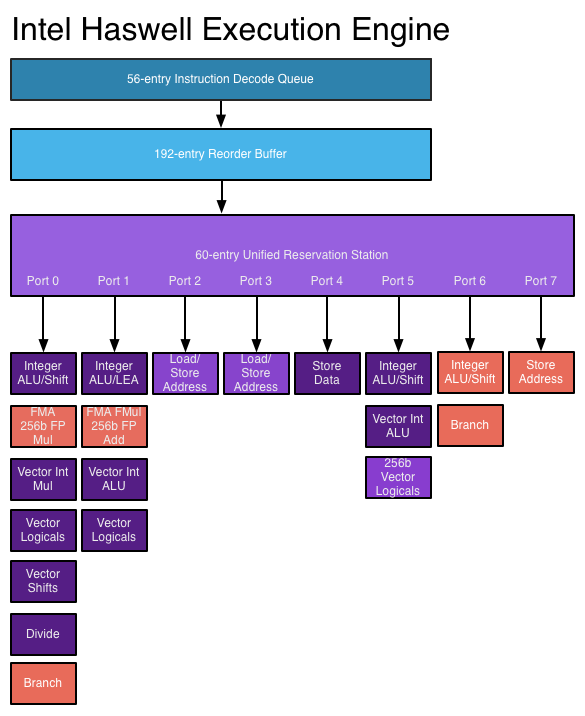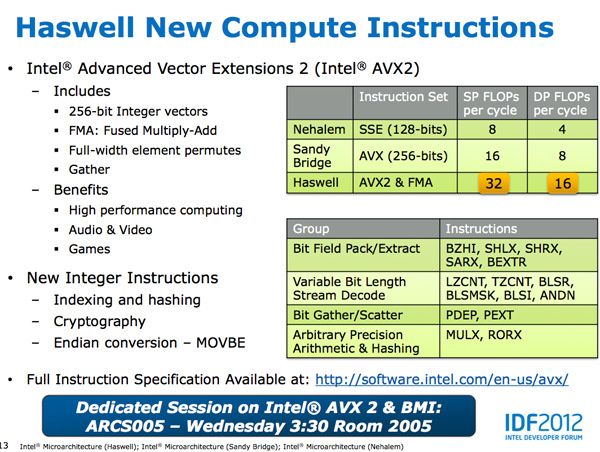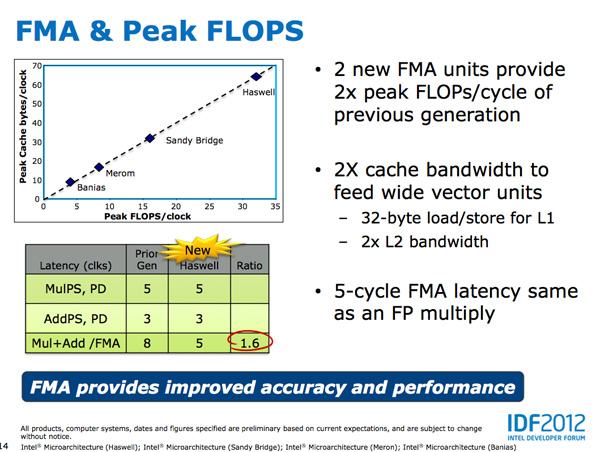Intel's Haswell Architecture Analyzed: Building a New PC and a New Intel
by Anand Lal Shimpi on October 5, 2012 2:45 AM ESTHaswell's Wide Execution Engine
Conroe introduced the six execution ports that we've seen used all the way up to Ivy Bridge. Sandy Bridge saw significant changes to the execution engine to enable 256-bit AVX operations but without increasing the back end width. Haswell does a lot here.
Just as before, I put together a few diagrams that highlight the major differences throughout the past three generations for the execution engine.

The reorder buffer is one giant tracking structure for all of the micro-ops that are in various stages of execution. The size of this buffer is directly impacted by the accuracy of the branch predictor as that will determine how many instructions can be kept in flight at a given time.
The reservation station holds micro-ops as they wait for the data they need to begin execution. Both of these structures grow by low double-digit percentages in Haswell.
Simply being able to pick from more instructions to execute in parallel is one thing, we haven't seen an increase in the number of parallel execution ports since Conroe. Haswell changes that.
From Conroe to Ivy Bridge, Intel's Core micro-architecture has supported the execution of up to six micro-ops in parallel. While there are more than six execution units in the system, there are only six ports to stacks of execution units. Three ports are used for memory operations (loads/stores) while three are on math duty. Over the years Intel has added additional types and widths of execution units (e.g. Sandy Bridge added 256-bit AVX operations) but it hasn't strayed from the 6 port architecture.
Haswell finally adds two more execution ports, one for integer math and branches (port 6) and one for store address calculation (port 7). Including both additional compute and memory hardware is a balanced decision on Intel's part.
The extra ALU and port does one of two things: either improve performance for integer heavy code, or allow integer work to continue while FP math occupies ports 0 and 1. Remember that Haswell, like its predecessors, is an SMT design meaning each core will see instructions from up to two threads at the same time. Although a single app is unlikely to mix heavy vector FP and integer code, it's quite possible that two applications running at the same time may produce such varied instructions. Having more integer ALUs is never a bad thing.
Also using port 6 is another unit that can handle x86 branch instructions. Branch heavy code can now enjoy two independent branch units, or if port 0 is occupied with other math the machine can still execute branches on port 6. Haswell moved the original Core branch unit from port 5 over to port 0, the most capable port in the system, so a branch unit on a lightly populated port makes helps ensure there's no performance regression as a result of the change.
Sandy Bridge made ports 2 & 3 equal class citizens, with both capable of being used for load or store address calculation. In the past you could only do loads on port 2 and store addresses on port 3. Sandy Bridge's flexibility did a lot for load heavy code, which is quite common. Haswell's dedicated store address port should help in mixed workloads with lots of loads and stores.
The other major addition to the execution engine is support for Intel's AVX2 instructions, including FMA (Fused Multiply-Add). Ports 0 & 1 now include newly designed 256-bit FMA units. As each FMA operation is effectively two floating point operations, these two units double the peak floating point throughput of Haswell compared to Sandy/Ivy Bridge. A side effect of the FMA units is that you now get two ports worth of FP multiply units, which can be a big boon to legacy FP code.
Fused Multiply-Add operations are incredibly handy in all sorts of media processing and 3D work. Rather than having to independently multiply and add values, being able to execute both in tandem via a single execution port increases the effective execution width of the machine. Note that a single FMA operation takes 5 cycles in Haswell, which is the same latency as a FP multiply from Sandy/Ivy Bridge. In the previous generation a floating point multiply+add took 8 cycles, so there's a good latency improvement here as well as the throughput boost from having two FMA units.

Intel focused a lot on adding more execution horsepower in Haswell without creating a power burden for legacy use cases. All of the new units can be shut off when not in use. Furthermore, Intel went in and ensured that this applied to the older execution units as well: in Haswell if you're not doing work, you're not consuming power.












245 Comments
View All Comments
Penti - Saturday, October 6, 2012 - link
Also FPU/SIMD has been a large part in later ARM designs and implementations. It's really a big deal as we saw with the chips lacking some of those parts. You shouldn't forget how important those bits are. Others have failed because they didn't take it seriously. That was 15-20 years ago even. Doesn't mean they are yet fighting x86-64 chips in high-end servers and workstation though. We will certainly see them entering that market by 2015 though.Arbee - Friday, October 5, 2012 - link
Cortex A9's big IPC improvement came from going out-of-order, which kind of ruins your argument.Similarly, the X360/PS3 PowerPC chips are strict in order and super ultra slow as a result - at 3.2 GHz they can't match a PowerMac G5 with out-of-order at 2.2 GHz. But I suspect that wasn't the point - Sony and MS can claim the eye-popping (in 2006) 3.2 GHz figure, and the heat production is certainly less than a PPC G5.
wumpus - Friday, October 5, 2012 - link
Has anyone seen an A9 in the wild? I don't doubt huge IPC improvements (back when O-O-O was new, it tended to double performance). My statement is that it will kill GIPS/W and that Intel can much more easily design a chip that can beat it in both raw performance and GIPS/W (note that your mention of heat production agrees with me).Also note I suspect that the goal of A9 is to keep the power low enough to keep it out of where Intel wants to go. A rough guess is that ARM might have a chance with dual issue o-o-o, but past that (roughly where Pentium Pro was designed) they can't really go.
ElvenLemming - Friday, October 5, 2012 - link
The Cortex A9 has been in most major phone/tablet SoCs for the past two or so years. Apple's A5, A5X; Samsung's Exynos 4210, 4212, 4412; TI's OMAP 4 series; Nvidia's Tegra 2 and 3.Cortex A15 is probably what you were thinking of that we've yet to see out in the wild. It's out-of-order like the A9, but with a great deal of other improvements.
ericore - Friday, October 5, 2012 - link
Currently AMD has the upper hand on the notebook segment on battery life. Haswell changes that, but as is always the case with Intel, they will be pricey. And that's why AMD will still have 50% of the market because vendors are cheap.Power savings are much less relevant on desktop front; I don't care so much about power as i do of heat. AMD X4 700, ship an awsome 4 core cpu for 75$. Technically, it has all that you need from a CPU. Add a Radeon 7770 (again cheap) and your golden. Ya Intel is faster, but both Intel and Nvidia have shitty low end products and that's even more true when you think of atom. 5-15% single threaded performance is not anything that is going to burry AMD lol.
On top of that, AMD has an atom KILLER, a contracts with all major console vendors.
Haswell will have surprisingly little impact on AMD; what I am saying is if you look at your own expectations, you'll realize they were highly inflated and you'll wonder why it didn't do more damage to AMD. I've explained the why. Nevertheless broadwell is a significant threat, and we'll probably see AMD start to lose market share (much more than with haswell) unless AMD can fight back and it will; but nobody knows if it will be enough.
A5 - Friday, October 5, 2012 - link
Uh, wow.Zink - Saturday, October 6, 2012 - link
http://www.tomshardware.com/reviews/gaming-cpu-rev...tipoo - Friday, October 5, 2012 - link
"Overall performance gains should be about 2x for GT3 (presumably with eDRAM) over HD 4000 in a high TDP part."Does this mean the regular GT3 without eDRAM cache will be twice the performance of the HD4000 and the one with the cache will be 4x? Or that the one with the cache will be 2x? In which case, what would the one with no cache perform like, with so many more EUs the first is probably correct, right?
tipoo - Friday, October 5, 2012 - link
"presumably with eDRAM"...So the GT3 in Haswel has over double the EUs of Ivy Bridge, but without the cache it doesn't even get to 2x the performance? Seems off to me, doesn't it seem like the GT3 on its own would be 2x the performance while the eDRAM cache would make for another 2x?DanNeely - Saturday, October 6, 2012 - link
It probably means that, like AMD, Intel is hitting the wall on memory bandwidth for IGPs. When it finally arrives, DDR4 will shake things up a bit; but DDR3 just isn't fast enough.